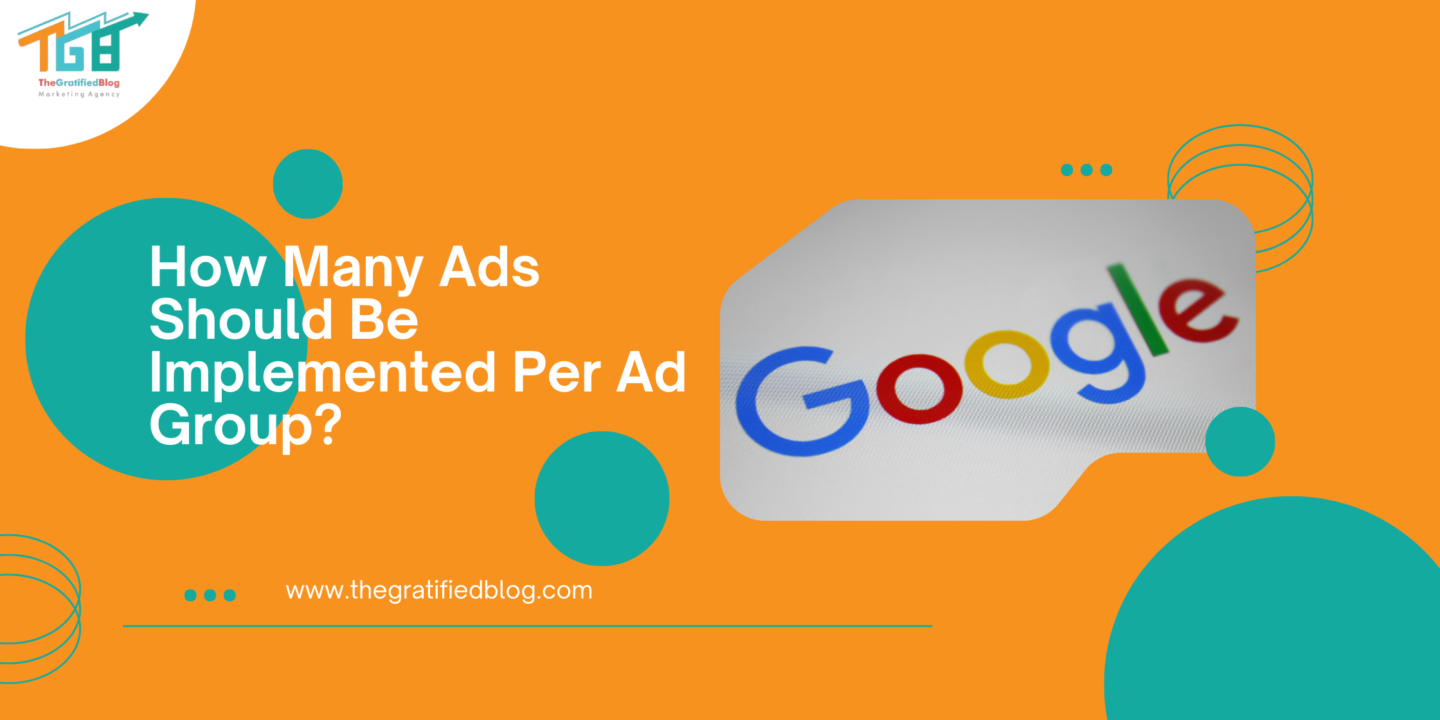
In the ever-changing realm of online advertising, where every click matters, finding the right balance between creativity, relevance, and efficiency is paramount. One of the critical decisions advertisers grapple with is determining how many ads should be implemented per ad group. This seemingly straightforward question opens up a realm of possibilities and considerations that can significantly impact the success of your campaigns.
As the digital marketplace continues its evolution, the intricacies of ad group optimization have become more pronounced. The significance of crafting compelling ad copies, tailoring messages to different audience segments, and maintaining ad relevance cannot be overstated. This brings us to the pivotal question: How many ads should be implemented per ad group?
This blog delves into critical topics: understanding ad groups and their role in online ads, the importance of ad rotation for impression distribution, finding the optimal ads-per-group balance, addressing the question of how many ads to implement, factors shaping ad group decisions, the best practice of having multiple search ads, benefits of this approach, and overcoming challenges and misconceptions.
So, let’s get started;
Definition Of Ad Groups And Their Purpose In Online Advertising Campaigns

Ad groups are organizational segments within online advertising campaigns that combine related advertisements and keywords. These units play a pivotal role, especially in platforms like Google Ads, offering a structured method for effectively managing and categorizing your ads and keywords.
Purpose of Ad Groups:
The primary purpose of ad groups is to enhance the relevance and targeting of your advertising efforts. They serve several crucial purposes within online advertising campaigns:
- Relevance: It allows you to create thematic clusters of ads and keywords highly relevant to a specific product, service, or topic. This relevance increases the likelihood that your ads will match the intent of users’ search queries.
- Improved Ad Performance: By grouping similar keywords and ads, you can tailor your messaging and match it with user intent. This leads to higher click-through rates (CTR), better ad engagement, and improved ad performance.
- Ease of Management: Ad groups provide a structured way to manage and optimize your advertising efforts. You can allocate budgets, set bid strategies, and monitor performance granularly, ensuring that each ad group receives the attention it deserves.
- Targeting: Ad groups enable precise targeting of different segments of your target audience. Create ad groups that target specific demographics, geographic locations, or user behaviors, allowing you to tailor your messaging accordingly.
- A/B Testing: Ad groups facilitate A/B testing by allowing you to compare different ad variations within the same theme. This way, you can experiment with different ad copies, headlines, and call-to-action buttons to identify the most effective messaging.
- Quality Score: In platforms like Google Ads, ad group relevance directly impacts your Quality Score. Better ad placements and improved results can result from a higher Quality Score and reduced costs per click.
- Ad Extensions: Ad groups provide a structured way to implement ad extensions, which enhance your ads with additional information like site links, callouts, and structured snippets. These extensions can increase the visibility and engagement of your ads.
Given your understanding of the definition of ad groups and their purpose in online advertising campaigns, let’s explore ad rotation and its importance in distributing ad impressions.
Explanation Of Ad Rotation And Its Significance In Distributing Ad Impressions

Ad rotation refers to determining how multiple ads within an ad group are displayed to users over time. In online advertising campaigns, ad rotation settings dictate how often each ad is shown in response to user searches or interactions. These settings enable advertisers to control the distribution of ad impressions, helping to optimize and improve the performance of their advertising campaigns.
Significance of Ad Rotation:
- Equal Exposure: Ad rotation settings aim to provide equal exposure to all ads within an ad group. This prevents a single ad from dominating impressions, ensuring each ad has a fair chance to display. This equal exposure is significant when testing different ad variations or A/B testing.
- Performance Testing: Ad rotation is vital in A/B testing and experimentation. By evenly distributing impressions among different ad variations, advertisers can accurately assess the effectiveness of each ad. This testing allows advertisers to identify which ad messages, headlines, or visuals resonate best with their audience.
- Optimization Opportunities: Ad rotation helps advertisers gather performance data on various ads. This data lets advertisers decide which ads to keep, pause, or modify. This iterative process of analyzing performance and adjusting ad content improves ad effectiveness.
- Reduced Bias: Without proper ad rotation, an ad that starts performing well might receive a disproportionately high number of impressions, leading to a biased assessment of its effectiveness. Ad rotation minimizes this bias by distributing impressions more evenly, ensuring a comprehensive view of ad performance.
- Campaign Goals: Different ad rotation settings can align with different campaign goals. For instance, an advertiser might choose to optimize for clicks if their goal is to drive traffic or optimize for conversions if they want to focus on generating sales or leads. Ad rotation settings allow customization based on campaign objectives.
- Ad Rank and Quality Score: Ad rotation can impact ad rank and Quality Score. By rotating ads, advertisers can gather data on which ads receive higher click-through rates (CTR) and engagement, positively influencing Quality Score and leading to better ad placements and lower costs.
- User Experience: Effective ad rotation enhances the user experience by presenting a variety of ad messages to users. This can result in more relevant ads, increasing the likelihood of users finding what they’re looking for and engaging with the ads.
Having discussed the explanation of ad rotation and its importance in distributing ad impressions, let’s explore the concept of striking the proper equilibrium: determining the ideal quantity of ads to incorporate within an ad group. In simpler terms, we’ll delve into the question of “How Many Ads Should Be Implemented Per Ad Group?” and the various considerations that come into play when deciding the number of ads to have in an ad group.
Finding The Balance: How Many Ads Per Ad Group?
Discussion On The Common Question: “How Many Ads Should Be Implemented Per Ad Group?”
One frequently debated topic in online advertising is determining the optimal number of ads to include within each ad group. While there isn’t a one-size-fits-all answer, there are several factors to consider when deciding how many ads to implement per ad group. Striking the correct balance is essential for effective ad performance and campaign success.
Factors To Consider When Deciding The Number Of Ads In An Ad Group

Several factors must be considered when determining the number of ads to include in an ad group. Here are six essential factors supported by evidence:
- A/B Testing and Experimentation: A/B testing involves comparing two or more ad variations to identify which performs better. A sufficient number of ads in an ad group is crucial for meaningful A/B testing. According to a Google Ads support article, it’s recommended to have at least three ads per ad group for effective testing and optimization.
- Statistical Significance: Statistical significance ensures that the results you observe are not due to chance. A larger sample size (more ads) is needed to achieve this.
- Diverse Targeting: Different segments of your target audience may respond differently to various ad messages.
- Ad Fatigue Prevention: Ad fatigue occurs when users become less responsive to repetitive ad content. Having multiple ad variations helps prevent ad fatigue by presenting different messaging and visuals.
- Target Audience Diversity: Your target audience may have diverse preferences and behaviors. Having multiple ads allows you to address different user needs.
Building upon your understanding of the optimal number of ads per ad group and the factors influencing this decision, let’s delve into why crafting three or more search ads within an ad group is highly effective.
Why Is Creating Three Or More Search Ads Per Ad Group A Best Practice
Advantages Of Including Multiple Ads In An Ad Group
- Increased Chances of Ad Relevance and Engagement: Having three or more search ads within an ad group allows you to experiment with different ad copy, headlines, and calls to action. This diversity increases the chances of one or more ads resonating strongly with various segments of your target audience. When your ads align closely with users’ search queries and intent, you’ll experience higher ad relevance. This relevance leads to better click-through rates (CTR), increased user engagement, and improved ad performance.
- Enhanced Ad Performance Insights: Multiple ads provide a broader pool of performance data, enabling you to make more informed decisions. By comparing the click-through rates, conversion rates, and other critical metrics of different ad variations, you Obtain valuable insights into the components of your ads that generate the most favorable outcomes. These insights guide your optimization efforts, allowing you to refine your messaging and strategies based on concrete data.
- Better Adaptability to Changing Market Trends: The digital landscape is dynamic, and market trends can shift rapidly. Multiple ads in rotation allow you to adapt swiftly to changing trends and user behavior. For example, if there’s a sudden shift in consumer preferences or industry dynamics, you can adjust your messaging in real time to remain relevant. This adaptability helps your ads stay current and maintains your campaign’s effectiveness despite evolving market conditions.
Now, let’s delve into a discussion concerning the obstacles and prevalent misconceptions associated with this strategy.
Overcoming Challenges And Common Misconceptions

Even though implementing multiple ads per ad group offers significant benefits, there are challenges and misconceptions that advertisers should be aware of. Overcoming these challenges and dispelling misconceptions is essential for effectively utilizing this best practice:
Challenges
- Ad Management Complexity: Challenge: Managing multiple ads can be complex and time-consuming. Solution: Utilize ad management tools provided by advertising platforms to streamline the process—group ads with similar themes and messaging for easier management.
- Ad Relevance and Quality: Challenge: Ensuring all ads remain relevant to the ad group’s theme can be challenging. Solution: Regularly review and update ad content to match evolving trends and user preferences. Align your ad variations with specific keywords to maintain relevance.
- Limited Resources: Challenge: Smaller businesses with limited resources might need help to create and manage multiple ads. Solution: Prioritize critical products or services for ad variation. Focus on incremental changes and gradually expand the number of advertisements as resources allow.
Common Misconceptions
- Diluted Ad Group Focus: Misconception: Adding more ads will dilute the focus of the ad group. Reality: Creating multiple ads within a focused theme enhances relevance and engagement. It only dilutes focus if ad variations remain closely related.
- One “Best” Ad Variation: Misconception: One ad variation always performs best. Reality: Performance can vary based on user intent, time of day, and other factors. Multiple ads allow for a holistic view of performance.
- Unnecessary Complexity: Misconception: Adding more ads complicates campaigns without adding substantial value. Reality: The added complexity is manageable with proper organization. The value lies in improved insights, relevance, and engagement.
- Higher Costs: Misconception: Having more ads will significantly increase advertising costs. Reality: While costs may increase slightly, the improved performance and optimization from A/B testing can lead to higher returns on investment.
- Unpredictable Outcomes: Misconception: Testing multiple ad variations will yield unpredictable results. Reality: While outcomes can’t be predicted with certainty, A/B testing allows for informed decision-making based on statistically significant data.
Conclusion
Now that you have insights into how many ads should be implemented per ad group? Then why not consider applying this approach and observing the outcomes it can yield?
If you have any inquiries about this subject, please don’t hesitate to share your questions in the comments below. We’ll gladly provide answers and assistance.
Thanks for reading 🙂








No Comments